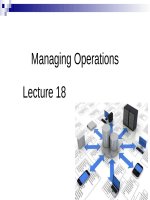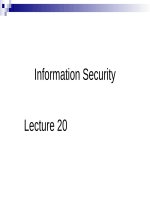Lecture Business management information system - Lecture 31: Understanding a networked world
Bạn đang xem bản rút gọn của tài liệu. Xem và tải ngay bản đầy đủ của tài liệu tại đây (820.99 KB, 51 trang )
Understanding A Networked
World
Lecture 31
Today’s Lecture
n
n
Understanding A Networked World
¨ The Internet Mindset
¨ Where’s the Value in a Network?
¨ The Rules of Networks
Moving Forward
¨ Understanding Users
¨ Increasing Executives’ Understanding of IT
Understanding A Networked World
n
Our networked world has different
characteristics from the non-networked
world many people are used to living in
Understanding A Networked World
The Internet Mindset
Just as PCs turned the mainframe data processing
mindset upside down, this new world of
communications, with its multi-dimensions and
interactivity, wreaks havoc with businesses unless
they understand and embrace the mindset of the
global online world
The Internet mindset:
1. Communication is personal, not mass market
2. Customer contact is interactive, not broadcast
3. The customer time frame is theirs, not yours
4. The culture is bottom-up, not top-down
Understanding A Networked World
The Internet Mindset cont.
1.
n.
n.
n.
n.
Communication is personal, not mass market
Communication is ‘up close and personal’, not top-down
mass marketing
Message to traditional marketing departments = “Your ad
copy is boring”
Some corporate Web pages are stuck in the traditional
advertising model, ‘duplicating’ the ‘printed page’
¨ THEY ARE USING THE WRONG MINDSET: MASS
MARKET RATHER THAN PERSONAL
Others get it ‘right’ and give people a way to create their
‘own’ pages e.g. My-Yahoo, My-CNN etc.
Understanding A Networked World
The Internet Mindset cont.
2.
n.
n.
Customer Contact is Interactive, Not Broadcast
The single most important point of view to take toward the
Internet is to view it as interactive, not broadcast:
¨ Incoming, not outgoing
In essence, the Internet is a customer’s window to
companies
Understanding A Networked World
The Internet Mindset cont.
n
It is substantially different from TV because customers
can initiate communications with a firm rather than
merely react to their ads
n
Customer-initiated dialog supported by the Internet
significantly challenges marketing departments,
customer support groups and fulfillment folks
Understanding A Networked World
The Internet Mindset cont.
3.
n.
n.
The customer time frame is theirs, not yours
Customers are closer than most companies have ever
experienced
Being put on hold increasingly irks
¨ Today’s consumers are busy with little patience with
waiting
Understanding A Networked World
The Internet Mindset cont.
¨
n
As with TV remote controls, customers who do not
get immediate satisfaction will switch to the
competition with a point and click
Assess any proposed Internet business solution:
¨
WILL OUR FIRM’S INTERNET STRATEGY TRULY
HELP OUR CUSTOMERS COMMUNICATE WITH
US?
Understanding A Networked World
The Internet Mindset cont.
4.
n.
n.
The culture is bottom-up, not top-down
The Internet is not the expert’s world where the few
impart their knowledge to the many
The message is clear for IS departments:
¨
IS cannot work in the top-down broadcast mode, “I’m
IS and I’m the expert, so here’s your solution
customer”
Understanding A Networked World
The Internet Mindset cont.
¨
More than ever, IS must get input from its
customers to determine the services they want,
when they want them and where they want them
n
Hearing directly from customers is both a goldmine
and a massive challenge, especially to those with a
broadcast mindset
n
FEEDBACK, FEEDBACK, FEEDBACK!!
Understanding A Networked World
Where’s the Value in a Network?
n
To leverage the Internet (or any network), it helps to
understand where value is created
n
When computers (or items containing computers) are
not networked, each one needs to provide both frontend and back-end intelligence (coupled intelligence)
n
Introduce a network and these two forms of intelligence
can be decoupled, and better optimized
Understanding A Networked World
Where’s the Value in a Network? cont.
n
The back-end intelligence (to store and process data) is
best when centralized, made robust, is stable, is
standardized, and can be housed in a core-shared
infrastructure
n
The front-end intelligence (for interacting with the user),
is most useful when it can be dispersed to a myriad of
devices that can be small, mobile, customized, and
specialized
Understanding A Networked World
Where’s the Value in a Network? cont.
n
Networks allow value in four places, leading to four
new kinds of businesses:
1.
2.
3.
4.
At the core and periphery
In common infrastructures
In modules
From orchestration
Understanding A Networked World
Where’s the Value in a Network? cont.
1.
n.
Core and Periphery Services
Value moves to the ends
¨ Value is in the core (leadership and strategy
handled by top management) and the periphery
(customer-facing employees making decisions
and taking actions) – or in the IT infrastructure and
end devices
Understanding A Networked World
Where’s the Value in a Network? cont.
2.
Common Infrastructures
n.
Elements of any infrastructure
¨
n.
An organization, a system, a business process…
That were distributed are being pulled together and
operated as a utility
Understanding A Networked World
Where’s the Value in a Network? cont.
3.
n.
4.
n.
Modules
Software, devices, organizational capabilities, and business
processes are being divided into self-standing modules so
that they can quickly and easily connect to form a value
chain for responding to circumstances
Orchestrating Modules
When modules are abundant, there’s value in being able to
bring them together
Understanding A Networked World
The Rules of Networks
n
Three distinguishing characteristics of e-economy:
1.
2.
3.
It is global
It favors soft things - intangibles, such as software,
information, ideas, and most importantly relationships over hard things, such as trucks, steel, and cement
It is intensely interlinked
The Rules of Networks cont.
1. Aim for Relationship Tech.
n
All about connecting
¨
Connecting more devices to a network exponentially
increases the value of the network for everyone involved as
so many new connections are created
¨
Today’s world is all about networks = connecting.
¨
With unlimited connections & abundant information, the
organization is peer-to-peer rather than hierarchical
The Rules of Networks cont.
1. Aim for Relationship Tech.
¨
Customer & company create together on a peer-to-peer basis,
they both get smarter together & develop a closer relationship
¨
Technology that enhances these relationships is called
relationship tech
¨
Company with the smartest customers wins – requires more
trust from both company & customer
The Rules of Networks cont.
2. Follow the Free
n
The best gets better and cheaper at the same time
¨
The network economy is founded on this principle of decreasing
price for increasing quality – smart companies anticipate this &
offer products for free
¨
The most valuable goods & services are those that are most
abundant – they increase the value of every other one
The Rules of Networks cont.
2. Follow the Free
¨
Netscape gave the browser away free & sold the servers. This
strategy worked until Microsoft with a large market did the same
thing & took away the market share
¨
How you make money in this market:
n
n
n
Aim for free, but only achieve cheap = same effect
Give away the core product & sell the service
Structure the business so that you will be profitable when your
product is free
The Rules of Networks cont.
3. Feed the Web First
n
More important to be on the right network or network
platform.
¨ It
is important to be on the right network, or
network platform – a Mac or Windows person?
¨ A companies
success depends on the standards it
chooses – choice of ERP packages & bolt-ons to
then choose from
The Rules of Networks cont.
3. Feed the Web First..
¨ In
the network economy, enterprises will shift their
focus from maximizing their own value to maximizing
the value of their network
¨ Its
to early to tell how important one wireless Internet
access platform will be over another & to whom the
choice will have the greatest value
Moving Forward
n
n
n
n
It is people who will lead us into this new business
world and the people who will be led.
First = discuss the followers
Then = what the leaders need to know to be
comfortable with talking about IT
N.B.: Not all people have the same inclinations to use
IT









